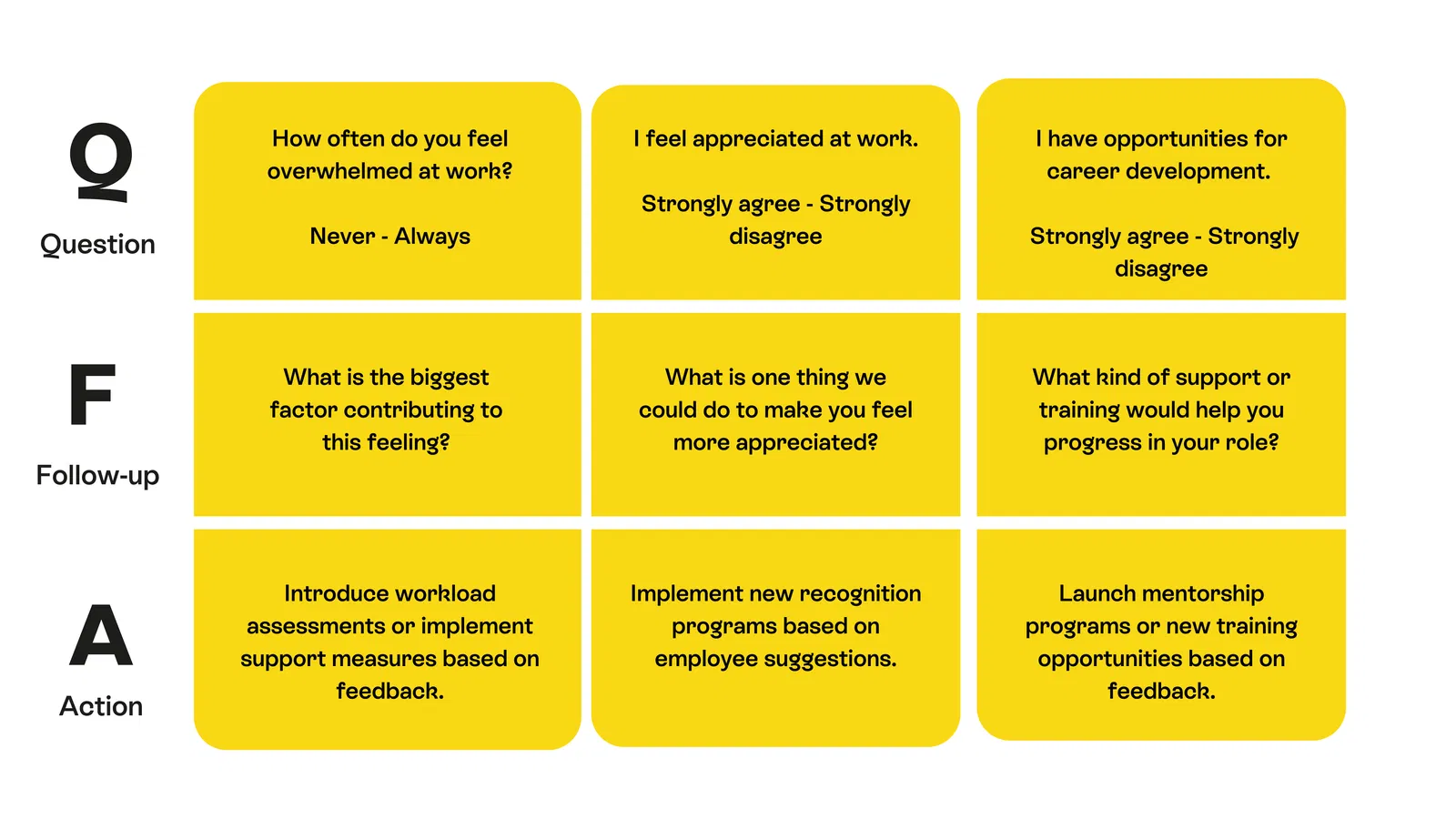Why Survey Segmentation Matters So Much In Employee Feedback
Aggregated data tells you what is happening – but not where or why. Segmentation is the solution!
Read MoreCreating effective employee engagement surveys can be tricky, especially if you’re new to running surveys.
You want to ask the right questions, get meaningful answers, and most importantly, take positive action based on the feedback you receive.
It’s a lot to balance.
That’s why Stribe created The QFA Framework – a simple 3 step method designed to help HR teams craft high-quality survey questions that lead to real change.
The QFA Framework is an easy 3 step structured approach to writing employee survey questions that guarantees better engagement and more useful insights.
The framework was created by the employee engagement software experts at Stribe and ensures that every question is:
The QFA Framework consists of three key parts: Question, Follow-up, and Action. Here’s how it works:
Start with a clear and neutral question that allows employees to express their thoughts.
Your question can be phrased as either a statement or a direct question but needs to include a rating scale of some kind so you can gather quantitative data.
Example rating scales include:
Using a rating scale is absolutely key to gathering data that will help you identify trends and measure progress over time.
Once you’ve asked your main question, we recommend always following up with an open-ended question.
Unlike the initial rating-based question, the follow-up question is qualitative and allows employees to elaborate on their responses – giving them a chance to offer context and more information.
This is where you uncover the ‘why’ behind the data, helping you gain deeper insights into employees’ experiences, thoughts and concerns.
Examples of follow-up questions include:
The final and most important step – take action.
Employees need to see that their feedback leads to real change.
Address the key themes from the survey responses, communicate what actions will be taken, timelines for when action will take place, and follow through on improvements.
This builds trust, increases participation in future surveys, and reinforces a positive feedback culture.

Traditional employee engagement surveys often fall flat because they ask vague questions that don’t allow employees to elaborate on their answers.
Or worse, lead to no visible action.
The QFA Framework overcomes these common mistakes by ensuring every survey question is structured to:
Some HR teams consider skipping the main question and just asking a follow-up question, but this is not good practice.
Without an initial rating-scale question, tracking trends over-time becomes much more difficult because all responses are free-text, making them harder to quantify.
The follow-up question is there to add context, not to replace structured data.
If you only ask an open-ended question, you’ll end up with a pile of feedback that’s difficult to analyse, compare, and act upon.
The best approach is to pair a clear, quantifiable question with a follow-up to get both measurable insights and deeper understanding.
Here are some examples of how The QFA Framework can be applied in different employee survey scenarios.
More burnout survey questions.
More culture survey questions.
More job satisfaction survey questions.

Surveys are one of the most powerful tools HR leaders can use to improve employee engagement – but only if they’re done right.
The QFA Framework ensures that your questions are well-structured, your employees have space to share meaningful insights, and most importantly, that their feedback leads to action.
By implementing this simple 3 step approach, you can create surveys that don’t just collect data, but drive positive change within your organisation.
About the author

Starting out her early career as a journalist, Jade Madeley is an accomplished content writer with 8+ years’ experience across business, personal finance, SaaS, human resources and employee engagement. Working with Stribe, she crafts insightful content that brings complex HR topics to life and drives meaningful action.
Aggregated data tells you what is happening – but not where or why. Segmentation is the solution!
Read MoreIf your organisation has been through failed surveys in the past, you might already be feeling the effects. Learn how to turn it all around.
Read MorePractical tips for getting employees to finally read your HR policies, plus how Stribe’s Employee Intranet can multiply your chances of success.
Read More